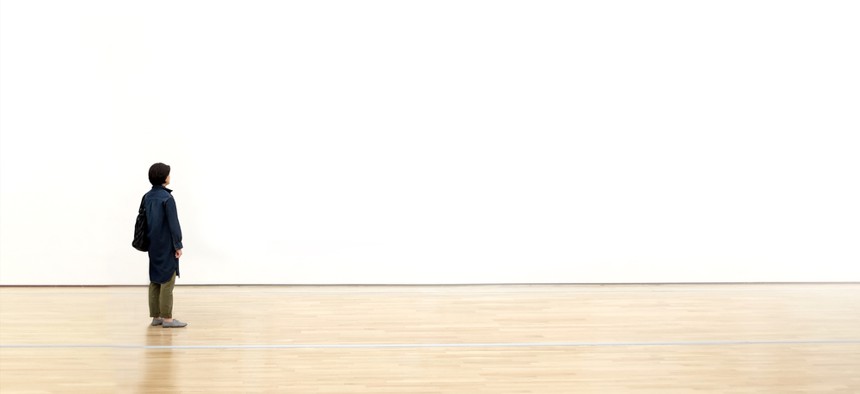Report: NYC arts and cultural nonprofits lack racial diversity

A person in an empty art gallery with a blank, white wall. Shutterstock
Legal Services of the Hudson Valley just released its 2019 annual report. Among the past year’s highlights: a newly created unit to help crime victims with civil legal issues. The state Legislature also provided a boost in funding to bolster the organization’s work providing free legal representation regarding housing and eviction cases. The report also states that the nonprofit serviced 12,122 clients in 2018. The report also gives insight into how the nonprofit spent 85% of its $17.5 million in revenue on programming last year. Take a look at the report here.
Day One New York has received a $4.1 million contract from the New York City Department of Social Services. This money will fund a relationship abuse prevention program, according to the City Record. The department also awarded Brooklyn Community Housing and Services a $594,720 contract to fund supportive housing for single room occupancy for homeless single adults at 40 Vanderbilt Avenue in Brooklyn. CAMBA received a $423,852 deal for similar services at James Bryant Homes, located at 2027 Madison Avenue in Manhattan. The department also awarded a $187,986 contract to St. John's Community HDFC to deliver services at 355 East 165th Street in the Bronx. In addition, the Department of Health and Mental Hygiene awarded a $721,512 contract to Brooklyn Bureau Of Community Service. What’s it for? “Disability,” according to the City Record.
Nonprofits are playing a role in Gov. Andrew Cuomo’s plan to revitalize downtown Auburn. The governor announced 13 projects as part of the plan, including efforts to improve the architecture and sites for the Schweinfurth Art Center and Cayuga Museum of History and Arts. Another project would establish a peer recovery facility that would house the nonprofit Nick’s Ride 4 Friends and other similar health care organizations to address addiction. To learn more about how the state plans to develop Auburn, click here.
Mayor Bill de Blasio says the city is creating more housing than ever for vulnerable people. The city financed 25,299 affordable housing units in fiscal year 2019, according to a recent City Hall press release. Of those homes, 54% serve families earning less than $48,000 per year. Most of the created units targeted people between 31% and 50% of area median income in New York City.
“We are making tremendous progress in our goal to expand affordable housing in our city, and this year we’ve produced a record number of homes for our most vulnerable friends and neighbors,” the mayor said in a press release.
The mayor has set a goal of creating 300,000 affordable homes by 2026, but his initiative has drawn criticism in the past for not making units adequately affordable – especially from nonprofits like the Coalition for the Homeless.
A new report states that arts and cultural nonprofits in New York City lack racial diversity. Specifically, white people make up roughly two-thirds of the workforce among such organizations – twice the share of the general population, according to a report commissioned by the city Department of Cultural Affairs, which looked at 65 organizations funded by the agency. Here are a few takeaways, taken more or less verbatim from the report.
- With respect to race and those of Hispanic origin, the respondent arts workforce is less diverse than New York City’s population. Whites represent 66% of the workforce, compared with their 32% share of the city’s population. In contrast, Hispanics, African Americans, and Asians are underrepresented – 10% of cultural workers identify as African American, compared with 22% of the city’s population; 11% identify as Hispanic, compared with 29% of city residents; and 6% identify as Asian, compared with 14% of city residents.
- Respondents selecting the role “community engagement” most closely match the racial makeup of the city as a whole. Service personnel are predominantly people of color, while boards and executive leadership are 70% and 68% white, non-Hispanic, respectively.
- In terms of gender, the overall arts workforce in this study is disproportionately female (65%) when compared to the general population of New York City (52% female), with males accounting for 31% and those identifying as transgender or gender non-conforming at under 1%. Board and executive leadership roles are 50% and 51% female, respectively.
- A large share (15%) of the arts workforce in this study identified as gay, lesbian, bisexual or queer. The role of executive leadership had the second-largest response rate for gay, lesbian, bisexual, or queer at 26%. Only the category of technical/production had a larger share at 27%.
- Eight percent of the arts and culture workforce in this pilot study reported having a disability, compared with 4% of all employed New York City residents and 11% of all New York City residents.